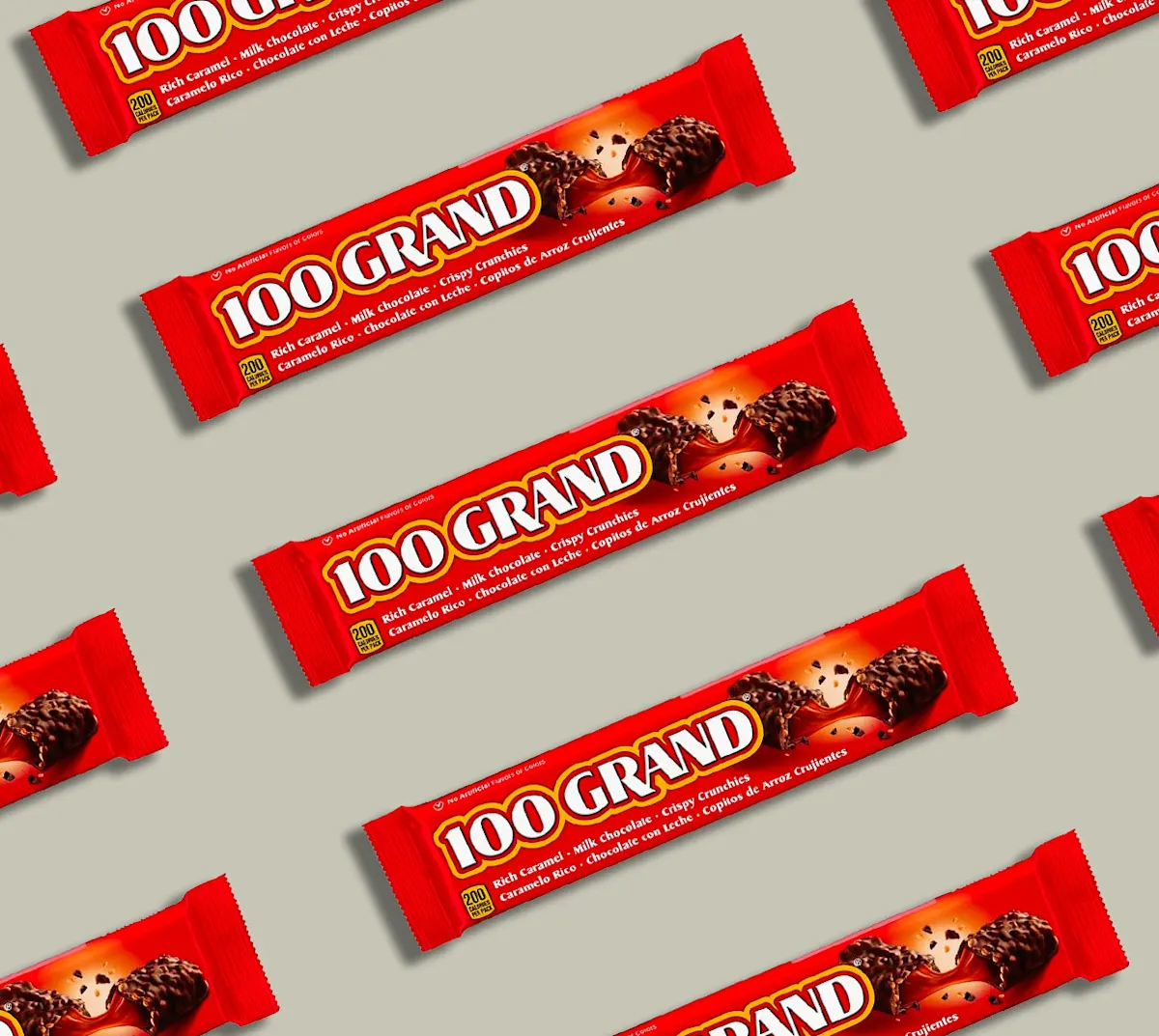*This article includes mentions of merchants who are partners of DoorDash, and DoorDash may receive a commission if you choose to make a purchase from these merchants.
First-tier candy bars sit near convenience store cash registers year-round, tempting shoppers to toss a Reese’s in with their Red Bull and Doritos. Second-tier candy bars require more effort to find, as they’re often scurried away in a back aisle for the quirky kids who make liking Mounds part of their personality. They’re stocked in candy variety packs at Halloween so trick-or-treaters get a Mr. Goodbar thrown in with their 12 Kit Kat Miniatures. Unfortunately, lost in that murky second tier of candy is the 100 Grand, a relic of an earlier era and a singularly excellent chocolate bar that’s due far more respect.
100 Grand deserves better. The bar's crispy rice cuts the sweetness of the thin chocolate casing, while the chewy caramel within brings it all together. This trilogy of textures — and rejection of chocolate as the standard dominant flavor — sets the 100 Grand apart from most mainstream offerings. Freewheeling and fun, delightfully irregular in a way that brings joy to the chaos Muppets among us, the 100 Grand bucks homogeneity and celebrates individuality. And, as the wrapper states of the buttery bar, “That's rich.”
“I hear a lot more from people loving the 100 Grand than I see it in the marketplace,” says Jason Liebig, a candy expert and brand historian. He says even more notable than the love for 100 Grand is how rarely he hears from people who dislike it.
Nestlé launched the bar in the mid-1960s as the $100,000 Bar, heavily promoting the chewiness and richness of the caramel. Within a few years, it was a first-tier candy, vying for a spot in the top ten most popular and sporting a killer tagline: “A fortune in flavor.” The name change came 20 years later, something Liebig attributes to the difficulty of trademarking the original moniker, which didn’t stand out enough.
Around the same time, the candy industry began to shift: Instead of creating or promoting new brands, companies produced new varieties of the same candy or merged bars under a single popular brand. In 1978, Reese’s spun-off into Pieces. Forever Yours became Milky Way Dark in 1989, the same year Snickers Ice Cream Bars came out. Today, there are 11 varieties of Snickers and twice that of Reese’s, including the 2019 rebranding of cult favorite Take 5 as Reese’s.
Liebig compares the trend to another part of pop-culture rife with promotional consolidation: Hollywood. “If it’s not a [superhero franchise] movie, you don’t know what it is,” he says, sizing up Reese’s and M&M’s as the blockbuster movies of the candy bar aisle. Big names bring in the big bucks and known quantities hold down corporate risk. The result? “Everybody else is just fighting for whatever other scraps of shelf space and attention there are,” Liebig says.
The marketing power and popularity of big brands along with the growth of non-chocolate candies (Skittles came out in the U.S. in 1979, Nerds in 1983) squeezed out single brand bars, meaning that the 100 Grand slowly slid out of the top tier of candy bars. And that’s not because it changed or fell out of fashion but simply because the candy racks were soon filled with so many other products.
Single bar brands like 100 Grand are a rarity today, in a world of Snickers Peanut Brownie, nearly a hundred varieties of Hershey's, and Reese's peanut butter cups in ghost, pumpkin, bat, and ugly sweater shapes. Apparently the bar sells well enough that its corporate candy overlords have yet to rebrand or discontinue it in favor of newer or flashier chocolates, but as if proving that its second-tier status starts at the top, 100 Grand lacks its own website — something sibling brands Baby Ruth, Crunch, and Butterfinger all have. The Ferrero Group, which bought the brand and its siblings from Nestlé in 2018, lists it on its North American website but only under a subcategory labeled “Additional Chocolate Brands,” alongside Goobers, Raisinets, and something called “Chunky.”
Still, Liebig considers this acquisition a good move for 100 Grand fans. “They’re a little more nimble,” he says. Nestlé is the world's largest food and beverage company, and while Ferrero is hardly tiny, the smaller company is freer to change things up. “If something exciting was going to happen with the 100 Grand, I think we're probably in the best position we've been in for that in a long time.”
100 Grand is unlikely to ever live up to bigger names of the candy universe, but old beloved brands have tons of potential. Until the bar has its day in the sun, if it ever does, I'll just keep sifting those bright-red wrappers out of the variety packs before offering the remaining bars to neighborhood children on Halloween — and definitely never stealing them from my kids' candy bags.
Shop HalloweenPHOTO CREDIT: Courtesy of Walgreens






